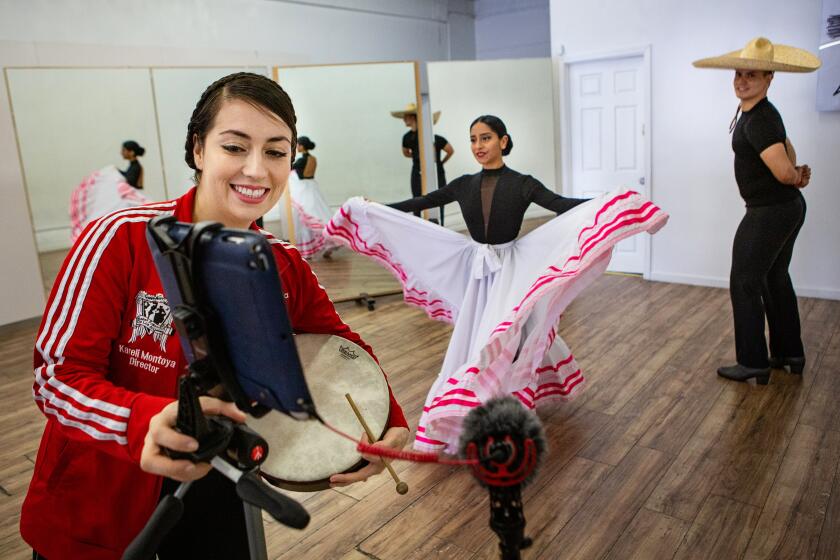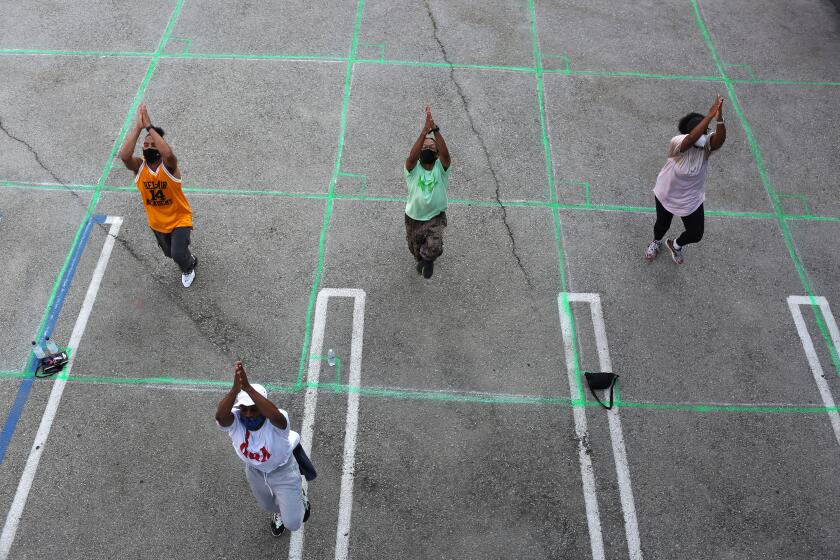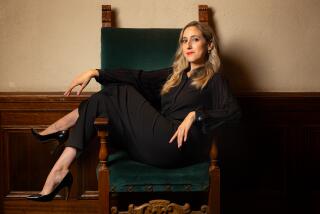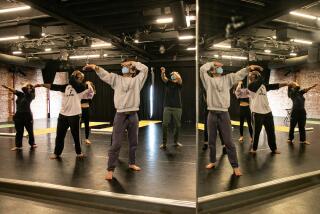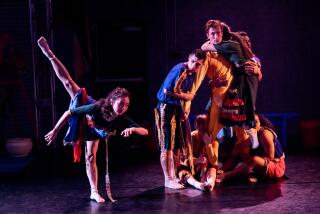What does it take to pull off a drive-in dance show? L.A. Dance Project explains
- Share via
As the pandemic stretches toward year’s end, dance companies have been forced to experiment and to move beyond virtual shows as a means of resuscitating the art of live performance. Some have found an unexpected lifeline not on the stage but in a parking lot.
In September, Ballet Folklórico de Los Ángeles held its first drive-in performance in Fullerton. In October, the contemporary company Clairobscur Dance used Zoom to develop new work later performed for audiences in cars at L.A.’s Original Farmers Market. Santa Monica’s Westside School of Ballet organized a drive-in dance film festival. And Heidi Duckler Dance presented drive-up or walk-up performances throughout L.A. over 10 days.
But what does it take to stage a COVID-19-compliant show? More than you might think.
Last month L.A. Dance Project premiered its drive-in dance series, which included “Solo at Dusk,” a work choreographed by former Batsheva Dance Company members Bobbi Jene Smith and Or Schraiber.
On opening night, cars slowly entered L.A. Dance Project’s downtown parking lot as a masked attendant directed vehicles to frame the outdoor stage. Audience members were instructed to wear masks if they wanted to leave their windows open. If they preferred to be maskless, they could tune to a radio station frequency to hear the streamed performance score.
They were instructed to turn off headlights, so the slightly raised, makeshift stage was lighted only by portable lights. When one car struggled with directions, the dance company was prepared with a car-sized blackout blanket.
With eerie, gestural choreography, and the sound of the city as a backdrop, “Solo at Dusk” felt like stumbling into a secret ritual.
But as wildfires raged across the West Coast, filling the air with unhealthy ash and smoke, the company postponed shows soon after the premiere. About a month later, “Solo at Dusk” reopened and is nearly sold out. (Recent fires in Orange County renewed air-quality concerns but all remaining shows are continuing as scheduled.)
Developing a COVID-19-compliant season began during the early days of the pandemic, L.A. Dance Project Executive Director Lucinda Lent said.
Once Artistic Director Benjamin Millepied realized the pandemic would drastically upend the arts for an uncertain amount of time, he began thinking of new ways to keep performances alive, realizing “you don’t need 100 people to see a show for it to have impact and have meaning,” Lent said.
Originally, the company envisioned a small outdoor audience of 30 people. But Lent and Millepied learned they “weren’t allowed to do that, which is really frustrating when you see restaurants opening and you see art galleries having exhibits.”
The two struggled to find a protocol for staging a dance show and reached out to the World Health Organization and L.A. Mayor Eric Garcetti’s office for guidance.
“We were told that we could not have audiences that were not in vehicles,” Lent said.
The company pivoted to the drive-in format with a micro-audience to ensure everyone had a clear view of the dancing. Only eight cars ($100 per car, with a maximum of six people inside each) are able to attend at one time in L.A. Dance Project’s parking lot.
“It made it more intimate,” Lent said. “More communal in a way, than having 150 people sitting in a theater space.”
To keep dancers, choreographers and staff safe, the company developed a strict set of guidelines during the creation process, which began in August. The dancers were separated into pods — seven dancers, five crew members and two choreographers for “Solo at Dusk,” and four dancers, five crew members and two choreographers for another work, “The Betweens.”
The coronavirus crisis forced dance companies — folklórico, ballet, modern — to find ways to make money and reach audiences. Think screens, not stages.
Dancers signed an agreement, promising they would only interact with their pod. That meant isolating from family and friends and limiting activities outside of rehearsal. They could not protest, hike, ride in Ubers, eat at restaurants or go to bars.
“I truly believe the only way we were able to successfully create and complete the residency is because each member committed to following the protocol set forth so diligently,” Lent added via email.
Dancers learned choreography individually and outside as well as in masked sessions with Smith and Schraiber, whom the company housed in L.A. as part of the commission. If someone rehearsed inside L.A. Dance Project’s studios, the space was aired out for 24 hours. “Solo at Dusk” features just one duet — a dancer couple who lives together.
The cast took weekly COVID-19 tests and had their temperatures taken daily. The company also used a tracking system, a spreadsheet where dancers and crew input their specific whereabouts in each 24-hour period.
For choreographers Smith and Schraiber, working with L.A. Dance Project was an ideal environment for creating dance during the pandemic.
“It was very different from many other processes or things that I have been part of,” Schraiber said. “We had to find many solutions to the obstructions that stood in our way.”
One dilemma, Smith said, was the masks themselves.
“We were meeting these dancers for the first time, and a lot of them were meeting us for the first time. And all of those micro-gestures — the smiles or the frowns or all the reactions — we were kind of left to wonder what’s going on and how people are feeling.”
Dance studios including Edge Performing Arts Center and Ryan Heffington’s Sweat Spot have closed or gone virtual. Goodbye for now or goodbye forever?
The new normal for rehearsals eventually became part of the show.
Smith worked with company dancer Janie Taylor to design a floral mask as a costume piece. “One rehearsal I was like, what if flowers grow over their faces. After all this time of not seeing our faces, nature would take over and overwhelm us,” Smith said. “From this oppression, something would grow over us.”
The idea behind the costume floral mask began to inspire the piece itself.
“We started to ask, who are these people that don’t have eyes to cry and don’t have a mouth to speak or sing,” Smith said. “How do they communicate, and how do they express themselves when so much has been taken away from them?”
Lent said the performances are not a huge moneymaker for L.A. Dance Project, considering the cost of commissioning choreographers, paying dancers a full-time salary and building the 30-by-30-foot outdoor stage, an exhausting assembly process that took six hours. The hope is to continue performing the two works in early spring, along with finding a sponsor or donor to underwrite shows, which would allow the company to begin making a profit.
“It’s more about still giving people the opportunity to see art and dance and the joy that gives to people, especially in a moment like this,” Lent said.
Transforming the dance model to survive the pandemic also means transforming the way audiences communicate at shows. The email instructions for “Solo at Dusk” included one suggestion: “Honk if you love dance!”
But when the opening-night performance ended and performers stepped up to take their bows, people in cars seemed hesitant. Then there was a cacophony of sound.
The ending “was a little awkward in the moment,” Lent said. “But when people did do that, it felt right.”
Drive-in dances
Where: L.A. Dance Project, 2245 E. Washington Blvd., Los Angeles
When: “The Betweens” 7 and 8:30 p.m. Nov. 17, 18, 19 and 22
Tickets: $100 per vehicle, six people maximum
Info: ladanceproject.org
More to Read
The biggest entertainment stories
Get our big stories about Hollywood, film, television, music, arts, culture and more right in your inbox as soon as they publish.
You may occasionally receive promotional content from the Los Angeles Times.
